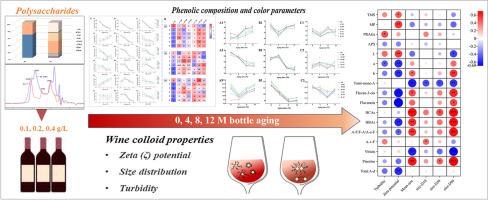Polysaccharide-induced colloidal stabilization of red wines: Impact on phenolic composition and color characteristic
IF 11
1区 农林科学
Q1 CHEMISTRY, APPLIED
引用次数: 0
Abstract
Polysaccharides play a crucial role in wine quality and colloidal stability. Two types of polysaccharides were applied to three wines with diverse initial phenolic and polysaccharide profiles to evaluate their effects on the color characteristics of the wines. Changes in the colloidal properties, phenolic composition, and color parameters of the wines were analyzed over a one-year bottle aging. The results revealed that the addition of polysaccharides consisting mainly of arabinogalactans (AG) tended to have a higher absolute zeta (ζ) potential value (below −10 mV), indicative of enhanced colloidal stability, while mannoprotein (MP) had little effect. However, the addition of both polysaccharides can influence the colloidal particle size and turbidity of the wines, with distinct variations observed based on the initial matrix composition, especially the polysaccharide content. Furthermore, both polysaccharides promoted the formation and accumulation of anthocyanin derivatives, especially pyranoanthocyanin, while AG had a greater effect, with a maximum increase of nearly 14% compared with the control group at 12 M. The color characteristic of the wines changed accordingly, with a significant increase in the red hue (a∗ value), particularly in wines characterized by low polysaccharide content and high polyphenol level. Notably, the modifications in colloidal properties induced by polysaccharide displayed a significant correlation with polyphenols and color parameters, indicating that a stable colloidal system facilitates color stability. In practical winemaking applications, the addition of polysaccharides should consider factors such as their type, concentration, and the balance of the initial wine composition.

多糖诱导的红葡萄酒胶体稳定性:对酚类成分和颜色特征的影响
多糖对葡萄酒的质量和胶体稳定性起着至关重要的作用。我们将两种多糖应用于三种初始酚类和多糖特征各不相同的葡萄酒中,以评估它们对葡萄酒颜色特征的影响。分析了葡萄酒在瓶中陈酿一年后胶体特性、酚类成分和颜色参数的变化。结果显示,添加主要由阿拉伯半乳聚糖(AG)组成的多糖往往具有更高的绝对 zeta 电位(ζ)值(低于 -10 mV),表明胶体稳定性增强,而甘露蛋白(MP)则影响甚微。然而,添加这两种多糖都会影响葡萄酒的胶体颗粒大小和浑浊度,根据初始基质成分,特别是多糖含量,会观察到明显的变化。此外,两种多糖都能促进花青素衍生物的形成和积累,尤其是吡喃花青素,而 AG 的影响更大,与对照组相比,在 12 M 的条件下,AG 的影响最大,增加了近 14%;葡萄酒的颜色特征也发生了相应的变化,红色色调(a∗ 值)显著增加,尤其是在多糖含量低、多酚含量高的葡萄酒中。值得注意的是,多糖对胶体性质的改变与多酚和颜色参数有显著的相关性,表明稳定的胶体系统有利于颜色的稳定。在实际酿酒应用中,添加多糖应考虑其类型、浓度和初始葡萄酒成分的平衡等因素。
本文章由计算机程序翻译,如有差异,请以英文原文为准。
求助全文
约1分钟内获得全文
求助全文
来源期刊

Food Hydrocolloids
工程技术-食品科技
CiteScore
19.90
自引率
14.00%
发文量
871
审稿时长
37 days
期刊介绍:
Food Hydrocolloids publishes original and innovative research focused on the characterization, functional properties, and applications of hydrocolloid materials used in food products. These hydrocolloids, defined as polysaccharides and proteins of commercial importance, are added to control aspects such as texture, stability, rheology, and sensory properties. The research's primary emphasis should be on the hydrocolloids themselves, with thorough descriptions of their source, nature, and physicochemical characteristics. Manuscripts are expected to clearly outline specific aims and objectives, include a fundamental discussion of research findings at the molecular level, and address the significance of the results. Studies on hydrocolloids in complex formulations should concentrate on their overall properties and mechanisms of action, while simple formulation development studies may not be considered for publication.
The main areas of interest are:
-Chemical and physicochemical characterisation
Thermal properties including glass transitions and conformational changes-
Rheological properties including viscosity, viscoelastic properties and gelation behaviour-
The influence on organoleptic properties-
Interfacial properties including stabilisation of dispersions, emulsions and foams-
Film forming properties with application to edible films and active packaging-
Encapsulation and controlled release of active compounds-
The influence on health including their role as dietary fibre-
Manipulation of hydrocolloid structure and functionality through chemical, biochemical and physical processes-
New hydrocolloids and hydrocolloid sources of commercial potential.
The Journal also publishes Review articles that provide an overview of the latest developments in topics of specific interest to researchers in this field of activity.
 求助内容:
求助内容: 应助结果提醒方式:
应助结果提醒方式:


